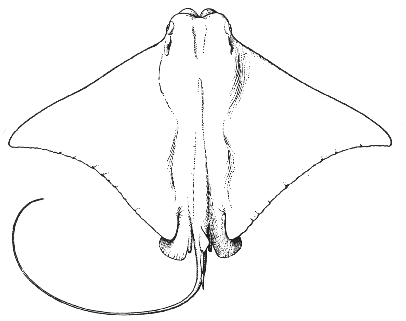Cow-nosed ray Rhinoptera bonasus (Mitchill) 1815
[Bigelow and Schroeder, 1953, p. 469.]
[Garman, 1913, pl. 37, as Rhinoptera quadriloba.]

Figure 33.—Cow-nosed ray (Rhinoptera bonasus), about 22 inches wide, Newport, Rhode Island. From Bigelow and Schroeder. Drawing by E. N. Fischer.
Description—
The cow-nosed rays with all their close relatives[82] have such characteristic outlines, the shape of their heads is so peculiar with the eyes and spiracles on the sides, and their large, flat, plate-like teeth are so different from those of any other Gulf of Maine skates or rays that they are not apt to be mistaken for anything else.
The species in question is characterized among its confreres by the indented contour of the front of its head, and by the conspicuously bilobed outline of the short so-called "subrostral" fin that projects forward from the lower side of the latter. The outer corners of the pectorals are pointed, and their posterior margins distinctly concave. The pelvic fins are small, reaching but a short distance back of the posterior corners of the pectorals. The dorsal fin is rounded above, originating about opposite the rear ends of the bases of the pelvics. The tail measured from the center of the cloaca is about twice as long as the body from cloaca to front of head on adults if not damaged, nearly 3 times on small specimens. The tail spines (1 or 2) are close behind the rear limits of the pelvic fins, and thus much further forward on the tail than those of the sting rays (p. 74). There usually are 7 series of teeth in each jaw, with up to 11 to 13 rows exposed, and in function simultaneously.
Size—
The cow-nosed ray has been said to grow to a breadth of 7 feet. But the largest specimen the width of which has either been actually measured or can be calculated from some other dimension, was only about 38 inches wide.[83]
Color—
Brownish above, white or yellowish white below. Some of them are marked both above and below with many narrow faint dark lines radiating out from the center of the disc.
General range—
Western Atlantic coast from middle Brazil to southern New England.
[page 77]Occurrence in the Gulf of Maine—
The cow-nosed ray has even less claim than the sting ray to be called a Gulf of Maine fish, for while schools of them appear occasionally near Woods Hole where 145 of them were taken in the fish traps in one day on one occasion, and while it is recorded from Nantucket, it has never been seen, actually, east or north of the elbow of Cape Cod.